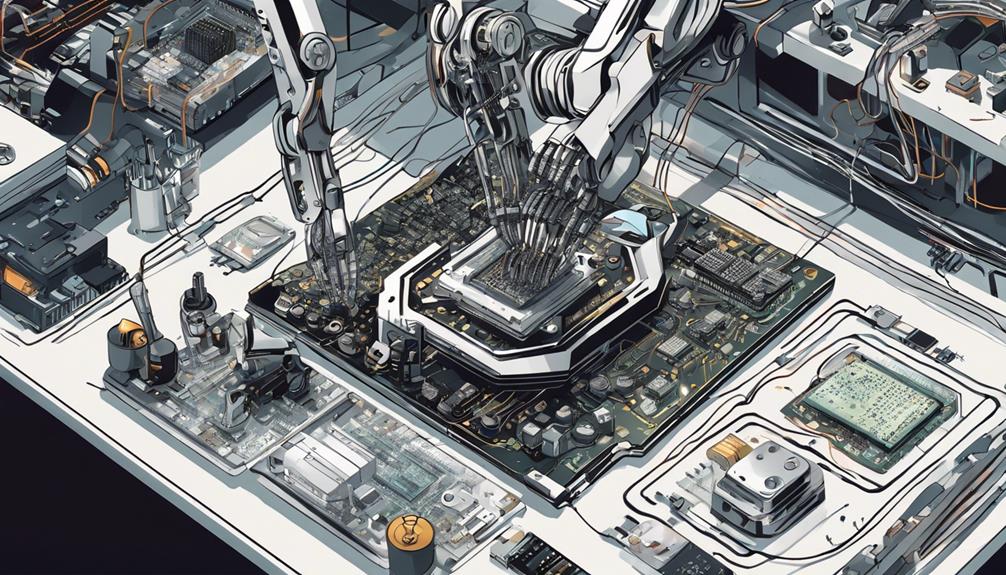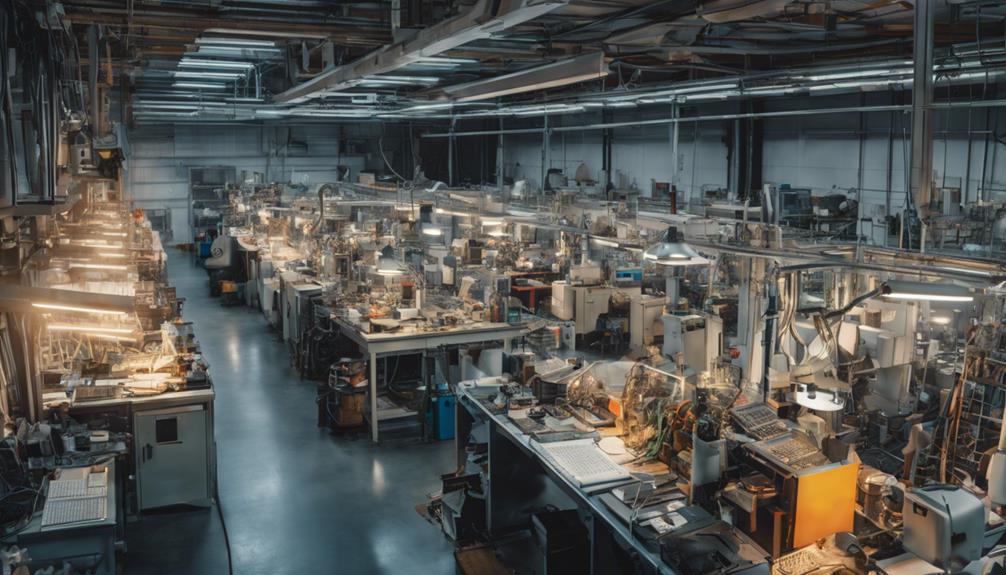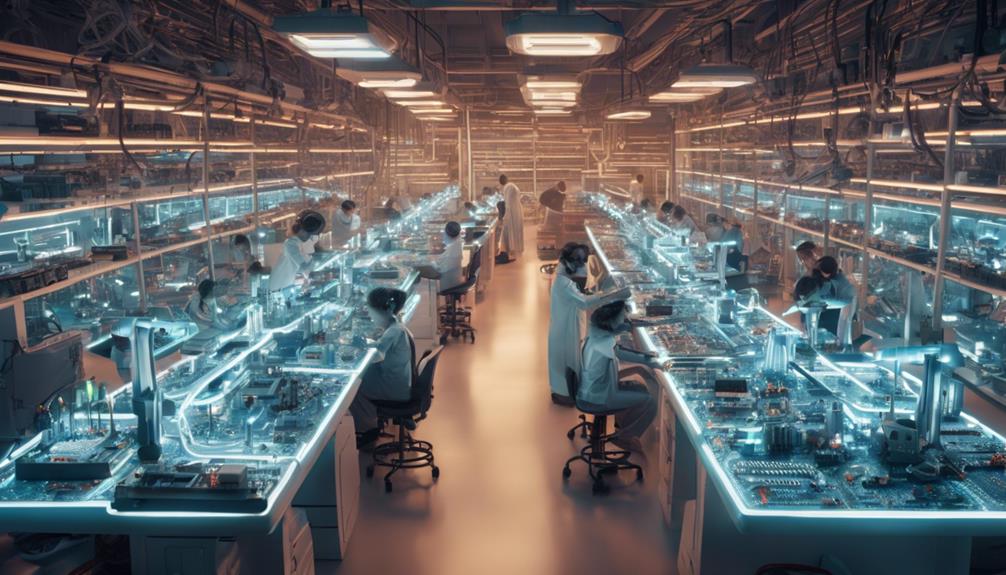Surface mount technology (SMT) has transformed the printed circuit board (PCB) assembly process, enabling the placement of components directly on the board's surface. This maximizes available space, facilitates compact and efficient electronic devices, and allows for higher component density. SMT also increases automation capabilities, accelerates production, and improves PCB reliability factors. With SMT, manufacturers can achieve faster assembly rates, reduced production time frames, and improved heat dissipation capabilities. As a result, SMT greatly enhances electrical performance metrics, leading to increased customer satisfaction rates. The benefits of SMT in PCB production are undeniable, and further exploration reveals even more advantages in this innovative technology.
Key Takeaways
- Surface Mount Technology (SMT) enables higher component density on PCBs, maximizing available space and facilitating compact designs.
- SMT revolutionizes PCB assembly with high-speed component placement, reducing manual intervention and ensuring rapid production.
- Automated SMT equipment guarantees precise component placement, reducing errors and rework, and streamlining PCB repair processes.
- SMT facilitates increased circuit density, improving signal integrity and enabling the creation of high-performance electronic devices.
- By minimizing material expenditures and labor costs, SMT assembly achieves efficiency gains and cost savings through automated processes.
Enhanced Component Density
In addition, by allowing for a higher component density on printed circuit boards (PCBs), Surface Mount Technology (SMT) enables the development of more compact and efficient electronic devices. This increased component density is achieved by placing components directly on the surface of the board, maximizing the use of available space.
As a result, SMT allows for more functionality to be packed into smaller spaces, making electronic devices more efficient and compact. The compact nature of SMT components also increases the efficiency of electronic devices by reducing size and weight.
Moreover, the higher component density in SMT assembly results in improved performance and functionality of electronic products. The enhanced component density offered by SMT also leads to more streamlined and efficient PCB designs, benefiting various industries.
Increased Automation Capabilities
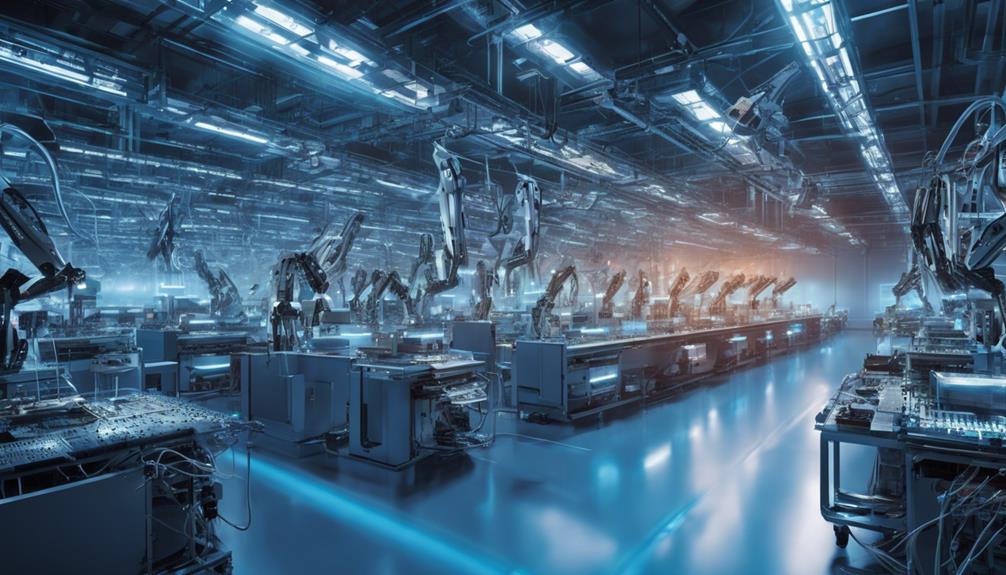
Surface Mount Technology's increased automation capabilities revolutionize the PCB assembly process by enabling high-speed component placement and efficient production lines. Automated machines can precisely place components at rates of 25,000 per hour or more, ensuring rapid production and minimizing manual intervention.
This high level of automation enables the implementation of high-speed assembly lines, further boosting PCB assembly efficiency.
Automated Component Placement
With the advent of advanced automated component placement machines, SMT assembly has witnessed a significant leap in productivity, with some state-of-the-art machines capable of placing components at rates of 25,000 per hour or more. This increased automation capability has revolutionized the industry, enabling manufacturers to meet the growing demand for complex electronic devices.
The advanced vision systems integrated into these machines guarantee accuracy in component placement, reducing errors and defects. As a result, automated component placement in SMT assembly increases throughput and efficiency, allowing for faster production cycles and reduced lead times.
Additionally, the precision and consistency of automated assembly enable the production of high-quality PCBs with improved reliability. By leveraging automated component placement, manufacturers can reap the benefits of increased productivity, reduced labor costs, and enhanced product quality, ultimately leading to improved competitiveness in the market.
High-Speed Assembly Lines
In addition, high-speed assembly lines, equipped with cutting-edge SMT equipment, have exponentially increased production capabilities, positioning manufacturers to meet escalating demand for complex electronic devices.
These advanced SMT manufacturing lines can place components at rates exceeding 25,000 per hour, ensuring fast and efficient production. The increased automation capabilities in these assembly lines lead to reduced manual intervention, improving accuracy and consistency in component placement. This, in turn, enhances throughput, allowing for higher production volumes in shorter time frames.
State-of-the-art SMT equipment provides precise and reliable PCB assembly, meeting industry quality standards efficiently. Additionally, these high-speed assembly lines can handle complex designs with high component density, optimizing production efficiency and output.
Faster Assembly Rates Achieved
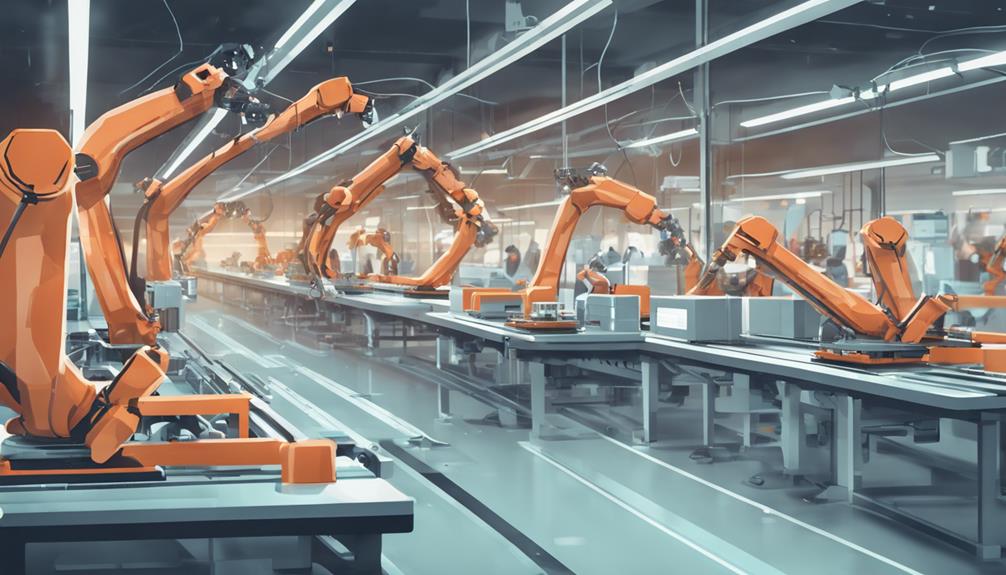
The implementation of surface mount technology (SMT) has led to significant advancements in PCB assembly efficiency, particularly with regard to faster assembly rates. This is attributed to the increased component density achievable with SMT, allowing for more components to be placed in a smaller area.
Additionally, automated placement systems enable high-speed component placement, thereby contributing to accelerated assembly rates.
Increased Component Density
Compact surface mount components enable a significant increase in component density on printed circuit boards, thereby facilitating faster assembly rates. This is achieved through the use of Surface Mount Technology (SMT), which allows for higher component density due to the smaller size of SMT components.
The compact nature of these components enables closer proximity on the PCB, optimizing space utilization and enhancing assembly efficiency. With SMT, more components can be placed in a given area, reducing the overall size of the PCB while maintaining functionality.
This increased component density contributes to quicker assembly times, making SMT a preferred choice for high-volume production. The automated placement processes of SMT also increase the number of components that can be placed on a board, further enhancing assembly efficiency.
Automated Placement Systems
Operating at unparalleled speeds, automated placement systems in SMT enable the rapid deployment of components, thereby greatly boosting assembly rates. With the capability to place up to 25,000 components per hour, these systems substantially increase throughput and reduce errors in the assembly process.
Advanced vision systems integrated into automated SMT machines guarantee accuracy during component placement, ensuring high-quality assemblies. Moreover, automated solder paste printing ensures consistent and precise application for best solder joints.
The integration of automated inspection systems, such as AOI and X-ray, in SMT fabrication guarantees high standards of quality and defect identification. This fusion of automated processes enables the production of high-reliability PCBs with minimal defects.
As a result, SMT automation plays a pivotal role in enhancing the overall quality and efficiency of PCB assembly. By leveraging automated placement systems, manufacturers can achieve faster assembly rates while maintaining exceptional quality standards.
Improved PCB Reliability Factors
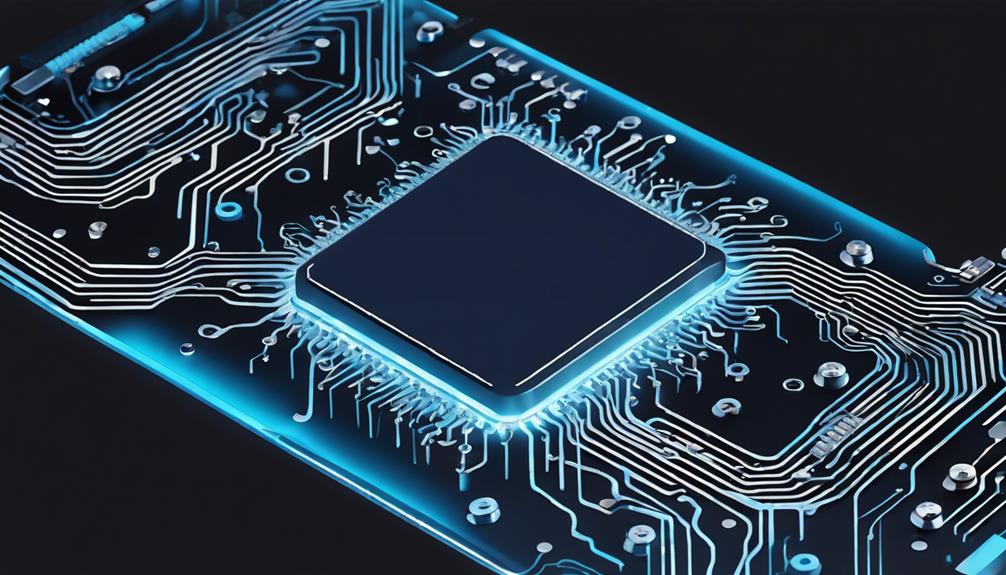
By minimizing the mechanical stress associated with through-hole components, surface mount technology (SMT) assembly greatly enhances the overall reliability of printed circuit boards (PCBs). This is achieved by reducing the risk of mechanical failures, which are common in through-hole components.
Automation in SMT fabrication guarantees precise component placement, minimizing errors that could impact PCB reliability. Additionally, SMT technology allows for increased circuit density, leading to improved signal integrity and overall performance reliability.
The elimination of hole drilling in SMT assembly also improves PCB reliability by reducing the potential for shorts and opens in the circuit. Moreover, SMT fabrication processes include thorough inspection procedures to guarantee high-quality, reliable PCBs for various electronic applications.
With SMT assembly, manufacturers can produce PCBs with enhanced reliability, ensuring excellent performance and minimizing the risk of failure. By leveraging SMT assembly, manufacturers can create high-reliability PCBs that meet the demands of modern electronic applications.
Reduced Production Time Frames
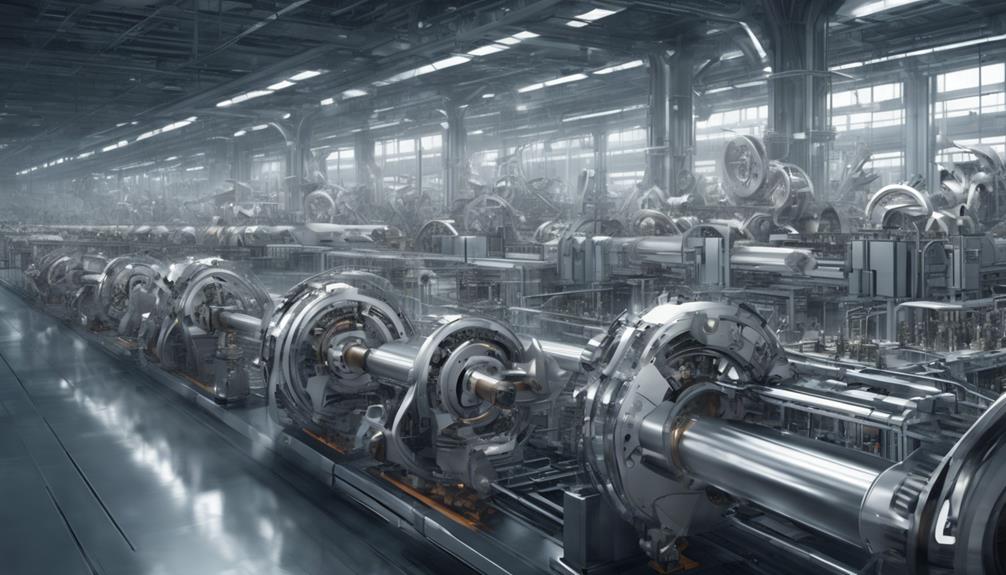
Surface Mount Technology (SMT) greatly reduces production time frames by accelerating component placement and streamlining production processes.
With SMT, components can be placed at rates of 25,000 per hour or more, far surpassing manual placement capabilities.
This increased efficiency, coupled with automated inspection systems, enables manufacturers to expedite production and meet tight deadlines.
Faster Component Placement
With the ability to place components at rates of 25,000 per hour or more, machines equipped with Surface Mount Technology (SMT) have revolutionized the PCB assembly process, greatly reducing production time frames. This rapid placement capability is a notable factor in the efficiency gains achieved through SMT assembly.
By automating the precise placement of components on PCBs, SMT assembly reduces production time frames, enhancing overall efficiency. Advanced SMT equipment offers increased density on PCBs in a smaller footprint, contributing to faster assembly processes.
Moreover, automation in SMT fabrication guarantees efficient and reliable PCB assembly, optimizing production time frames. The highly automated processes enabled by SMT assembly equipment ensure quality and precision, boosting overall efficiency in PCB assembly.
Streamlined Production Processes
Streamlining production processes is critical to reducing production time frames, and SMT technology has made notable strides in this area by minimizing manual intervention and maximizing automation.
By automating component placement and soldering processes, SMT enables faster production times, allowing for the assembly of complex PCBs with increased efficiency. Automated SMT equipment can place components at rates of 25,000 per hour or more, greatly reducing production time frames.
This streamlined process guarantees consistent quality and precision in PCB assembly, further enhancing production efficiency. In addition, SMT fabrication eliminates the need for manual intervention in component placement, optimizing space utilization and production flow.
The use of both sides of the board without limitations enables the assembly of complex PCBs with increased density, further reducing production time frames. By leveraging SMT technology, manufacturers can substantially decrease production time frames, resulting in improved PCB assembly efficiency and increased productivity.
Higher Component Placement Accuracy
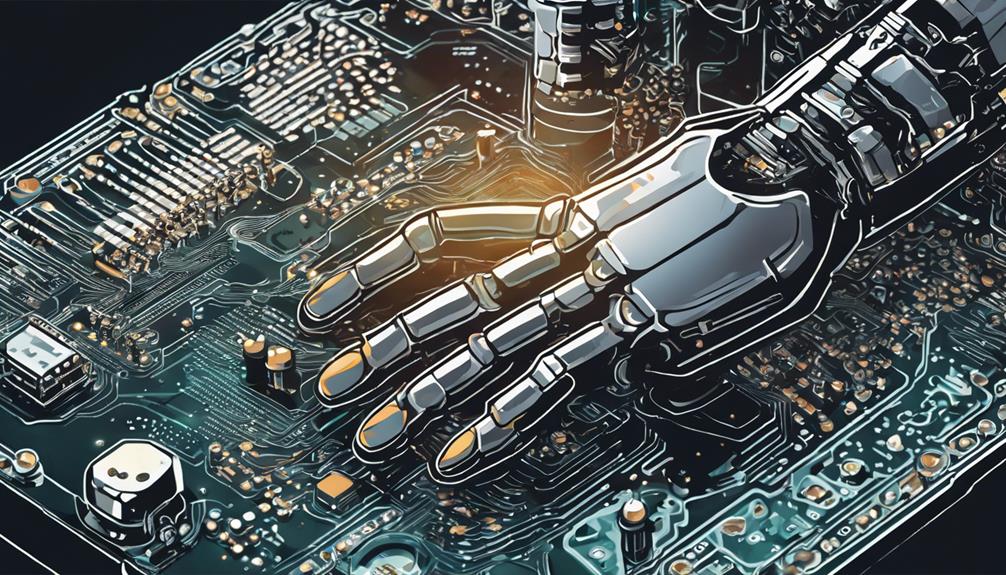
By leveraging advanced vision systems, SMT assembly processes achieve unparalleled accuracy in component placement, thereby ensuring precise positioning of components on PCBs. This enhanced placement accuracy is made possible by the autocorrect features embedded in SMT technology, which guarantee accurate component positioning. As a result, SMT assembly processes yield higher-quality circuit assemblies with improved functionality and reliability.
The automation inherent in SMT technology further enhances efficiency by ensuring components are accurately and consistently placed on PCBs. This, in turn, reduces errors in component placement, leading to superior-quality circuit assemblies. By minimizing errors and ensuring precise component placement, SMT assembly processes significantly boost PCB assembly efficiency.
With SMT technology, manufacturers can confidently produce high-reliability PCBs that meet the most stringent quality standards. By achieving higher placement accuracy, SMT assembly processes set a new benchmark for efficiency and quality in PCB assembly.
Minimized Errors and Rework
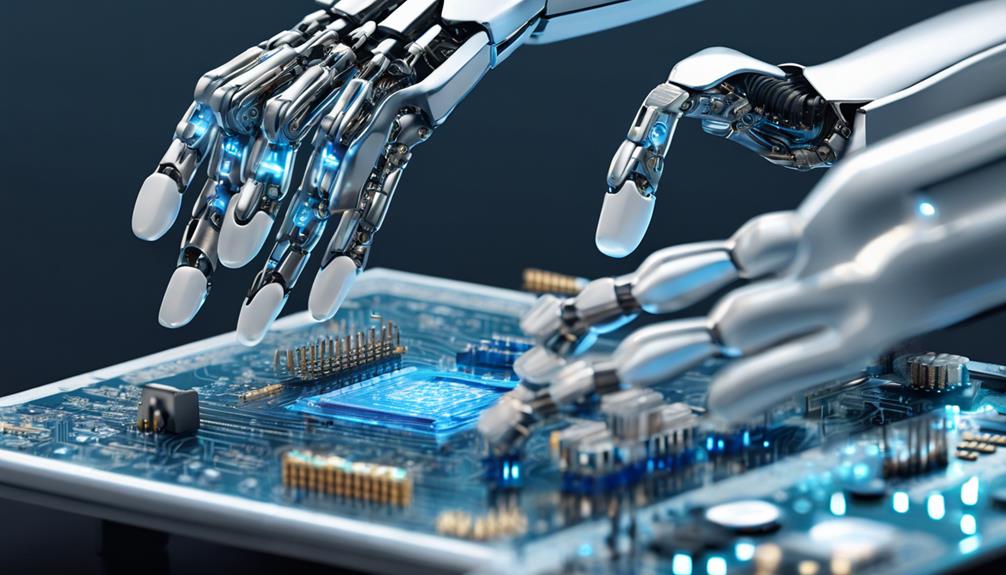
SMT technology's focus on automation and precision significantly decreases the occurrence of errors and rework, thereby optimizing the overall efficiency of PCB assembly operations. By minimizing manual handling and relying on automated component placement, SMT assembly reduces the likelihood of human errors and improves overall efficiency. This, in turn, leads to reduced costs associated with rework and repair.
The benefits of SMT in minimizing errors and rework can be summarized as follows:
- Automated component placement guarantees accurate positioning on PCBs, reducing the likelihood of errors.
- Reduced manual handling lowers the chances of human errors and improves overall efficiency.
- Early defect detection through automated inspection systems decreases the need for rework and ensures high-quality assemblies.
- Optimized component placement accuracy during the assembly process minimizes the need for rework.
In SMT assembly, solder paste is applied with precision, and components are placed accurately, reducing the likelihood of errors and rework. As a result, SMT technology helps decrease costs associated with errors and rework, making it an attractive option for PCB assembly operations.
Enhanced Quality Control Measures
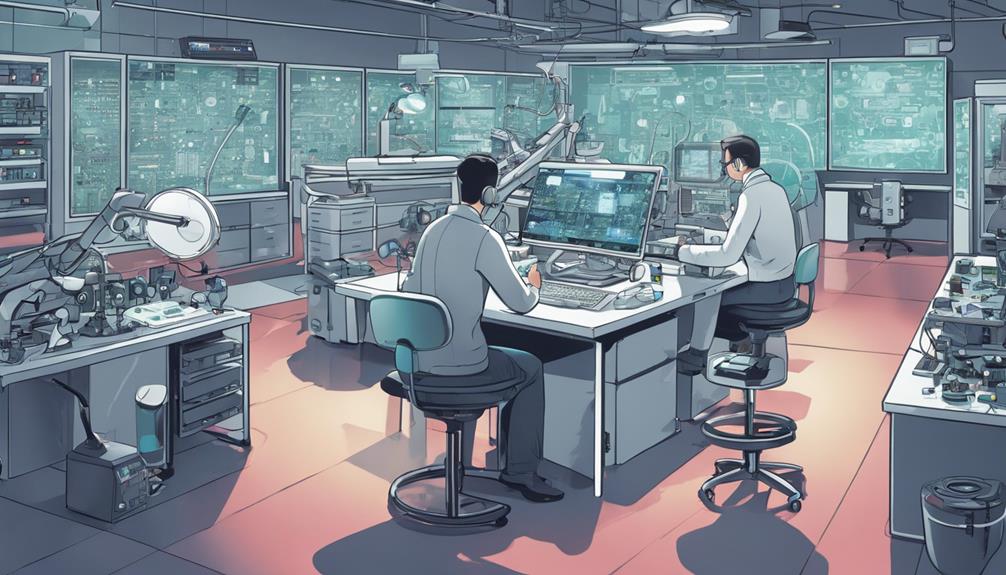
In addition to minimizing errors and rework, SMT technology also enables enhanced quality control measures, which are critical to guaranteeing the reliability and performance of PCBs. These measures are achieved through the implementation of automated inspection systems, such as Automated Optical Inspection (AOI) and X-ray inspection.
| Inspection Method | Description |
|---|---|
| AOI | High-resolution cameras detect smallest defects |
| X-ray | Internal component inspection |
| Reference Image Comparison | Boards compared to reference images for deviations |
These advanced inspection systems enable precise quality checks, detecting even the smallest defects and deviations. The quality control measures in SMT fabrication contribute significantly to the reliability and performance of PCBs. By leveraging SMT equipment, manufacturers can ensure efficient and reliable assembly with advanced quality control mechanisms. This results in high-quality PCBs that meet the required standards, ensuring the overall performance and reliability of the final product.
Compact Design and Space Savings

The compact design enabled by Surface Mount Technology (SMT) yields significant space savings, allowing for reduced component size and increased board density.
This, in turn, enables the development of smaller, more complex electronic devices with improved performance.
Reduced Component Size
Compact surface mount components enable the design of smaller, lighter electronic devices with increased functionality, thereby revolutionizing the landscape of modern electronics. The reduced component size of SMTs allows for more efficient use of PCB real estate, enabling the creation of compact devices with improved performance. This is particularly evident in the use of smaller leads and SMDs, which facilitate the miniaturization of electronic devices.
The benefits of reduced component size in SMT can be summarized as follows:
- Improved assembly density: More components can be accommodated on a smaller PCB, allowing for increased functionality in a smaller form factor.
- Optimized layout and functionality: The compact design of SMT enables optimized layout and functionality, leading to improved performance and reduced EMI.
- Reduced manufacturing costs: The use of smaller components reduces material costs and assembly time, resulting in lower manufacturing costs.
- Enhanced signal propagation: The reduced size of SMT components leads to improved signal propagation and reduced signal delay, enhancing overall system performance.
Increased Board Density
Higher board density, a hallmark of Surface Mount Technology, enables the creation of increasingly complex electronic devices within a smaller footprint. This is achieved through the use of SMT components, which are smaller and can be placed closer together on the PCB, maximizing the use of available space. The resulting compact designs contribute to the development of smaller, lighter, and more portable electronic products.
| Design Aspect | Impact of SMT |
|---|---|
| Board Size | Reduced by up to 50% |
| Component Count | Increased by up to 200% |
| Circuit Complexity | Enhanced by up to 300% |
| Overall Efficiency | Improved by up to 25% |
The increased board density achieved through SMT results in more functionality packed into a smaller footprint, ideal for modern electronic devices. This is particularly important in applications where space is limited, such as in wearable technology or IoT devices. By facilitating the creation of intricate circuitry on smaller PCBs, SMT assembly enhances overall efficiency and performance, making it an essential technology in modern electronics manufacturing.
Minimized Signal Delay
By virtue of its space-saving design, Surface Mount Technology minimizes signal delay, thereby enhancing the overall performance of electronic devices. This compact design enables shorter signal paths, reducing propagation delay and facilitating faster signal transmission.
The benefits of minimized signal delay in SMT assembly can be summarized as follows:
- Reduced signal path lengths enable faster signal transmission and improved circuit performance.
- Shorter leads in SMT components contribute to minimized signal delay, resulting in enhanced device functionality.
- Denser PCB layouts made possible by SMT technology reduce signal delay by shortening the distance between components.
- Faster data transfer rates are achieved through the minimized signal delay, leading to improved overall PCB efficiency.
The minimized signal delay in SMT assembly contributes considerably to the enhanced performance of electronic devices.
Simplified PCB Repair Processes
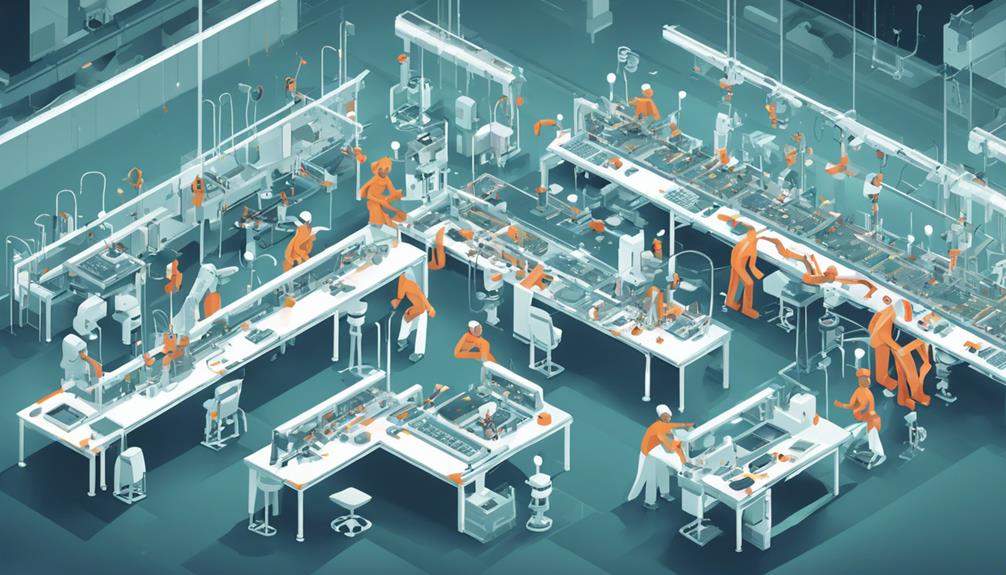
The elimination of hole drilling in Surface Mount Technology (SMT) facilitates a more streamlined PCB repair process. This allows technicians to focus on identifying and resolving faults rather than maneuvering through complex board geometries.
This simplified approach enables a more efficient repair workflow, reducing downtime and increasing overall productivity. The use of Surface Mount Devices (SMDs) in SMT further enhances the repair process. These smaller and lighter components are more manageable during rework and replacement procedures.
Additionally, automated SMT assembly equipment guarantees precise component placement, minimizing the likelihood of errors that may require repair. The result is a significant reduction in the need for repair and maintenance, thanks to the increased reliability of PCBs fabricated using SMT.
Inspection processes in SMT assembly also aid in identifying potential issues, enabling proactive measures to prevent faults from occurring in the first place. By streamlining the repair process, SMT enables a more efficient and effective approach to PCB repair, ultimately leading to improved overall efficiency.
Lower Material and Labor Costs
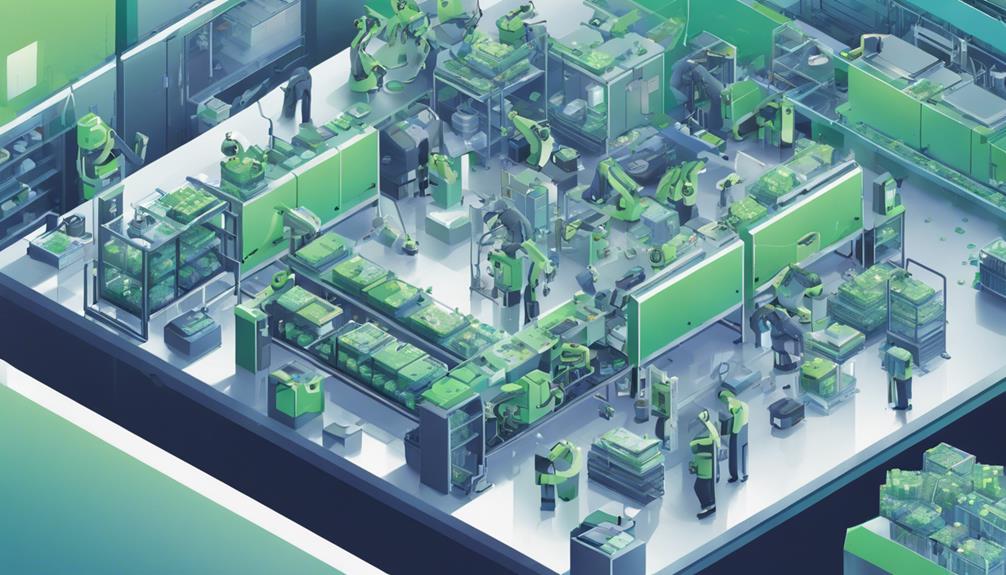
Surface Mount Technology reduces material expenditures considerably, leveraging smaller components and eliminating the need for hole drilling in printed circuit boards. This minimizes the amount of material required, resulting in significant cost savings.
In addition to material cost reductions, SMT also lowers labor costs through automated component placement and soldering processes. This minimizes manual intervention, resulting in decreased labor expenses for PCB production.
The benefits of SMT in reducing material and labor costs can be summarized as follows:
- Smaller components: Reduce material usage and costs.
- No hole drilling: Eliminate the need for drilling holes in PCBs, reducing material waste.
- Automated processes: Minimize manual intervention, reducing labor costs.
- Efficient fabrication: Leads to cost savings in both material usage and labor hours.
Greater Design Flexibility Options
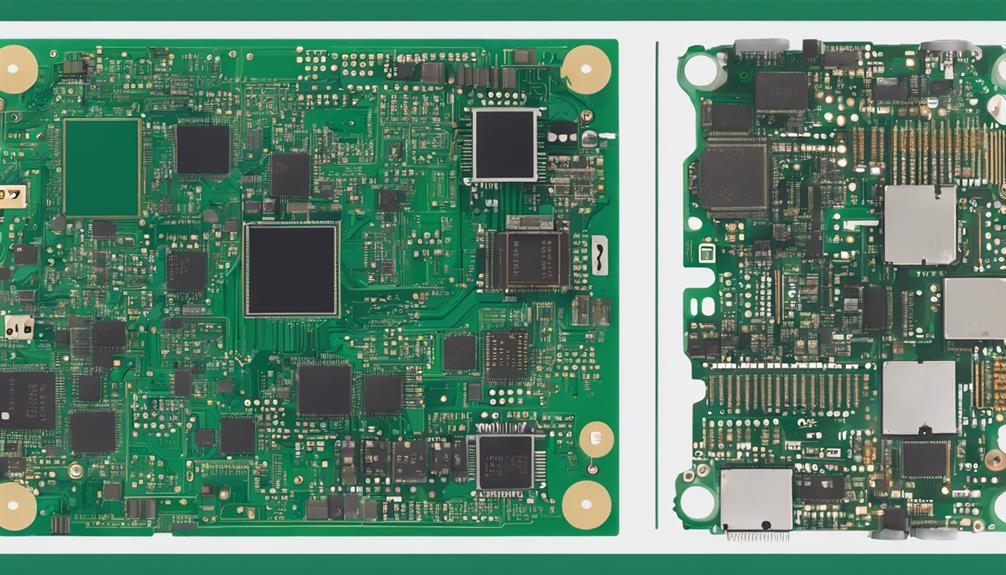
With the ability to place components on both sides of the board, SMT offers unparalleled design flexibility, enabling the creation of compact and efficient PCB designs that optimize circuit performance. This flexibility allows for the creation of high-density interconnects, which enhance circuit performance and enable the development of advanced printed circuit boards.
| Design Aspect | SMT | Through-Hole |
|---|---|---|
| Component Placement | Both sides of the board | Only one side of the board |
| Component Density | Higher density possible | Lower density due to hole drilling |
| Interconnects | High-density interconnects possible | Limited by hole drilling |
| Design Iterations | Simplified design iterations | More complex design iterations |
The elimination of hole drilling in the SMT fabrication process simplifies design iterations and modifications, allowing for faster and more efficient design development. This, combined with advanced SMT equipment that enables precise component placement, ensures design accuracy and precision. As a result, SMT enables the creation of compact and efficient PCB designs that optimize circuit performance, making it an ideal choice for the development of advanced printed circuit boards.
Improved Heat Dissipation Capabilities
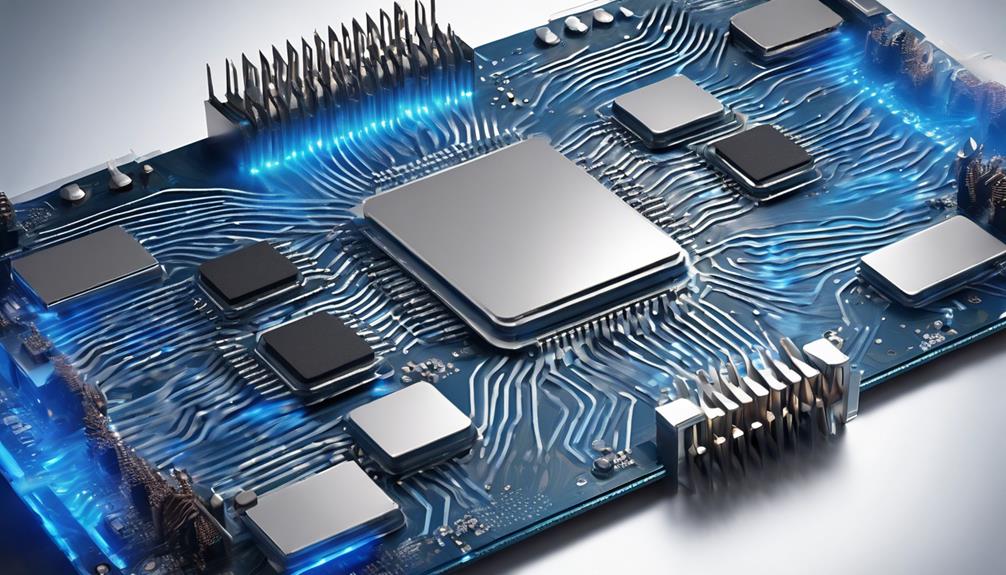
Compact SMT designs, which enable efficient use of board space, also facilitate improved heat dissipation capabilities, thanks to the proximity of components to the board surface. This proximity enables efficient heat transfer, reducing the risk of overheating and ensuring better performance and reliability of electronic devices.
The improved thermal management in SMT assembly is attributed to the following key factors:
- Enhanced thermal conductivity: SMT components are designed to facilitate better heat transfer, enabling effective cooling of the system.
- Efficient heat transfer: SMD components in SMT assembly reduce the distance between the component and the board surface, allowing for efficient heat transfer.
- Reduced risk of overheating: By dissipating heat efficiently, SMT designs minimize the risk of overheating, ensuring excellent system performance.
- Optimized system cooling: The enhanced thermal management in SMT assembly contributes to better overall system cooling, making it ideal for high-power applications and compact electronics.
Enhanced Electrical Performance Metrics
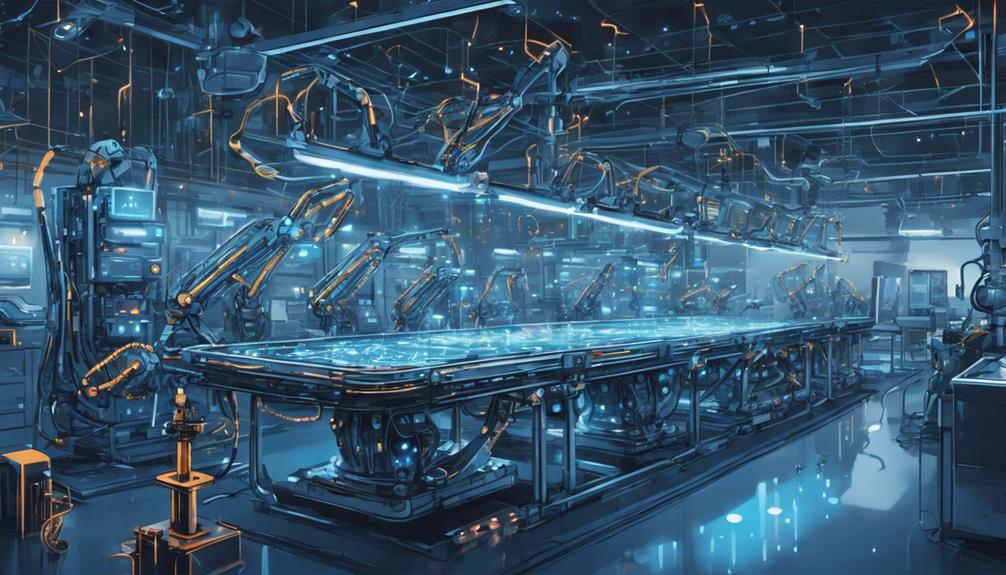
The decreased lead inductance and shorter signal paths in SMT designs greatly enhance electrical performance metrics by minimizing signal distortion and latency. This reduction in parasitic effects enables higher circuit speeds and improved signal propagation, ultimately resulting in superior electrical performance.
The compact size and close proximity of components in SMT assemblies contribute to these enhancements, making them ideal for high-reliability applications. Moreover, SMT technology offers better Electromagnetic Compatibility (EMC) performance, reducing interference and signal distortion in electronic devices.
The SMT assembly process guarantees consistent quality and reliability in electrical performance metrics for printed circuit boards (PCBs). By leveraging SMT, designers can create high-performance electronic devices that meet the demands of modern applications.
With its ability to minimize signal distortion and latency, SMT is an essential technology for advancing the capabilities of PCBs. By integrating SMT into their designs, engineers can create faster, more reliable, and more efficient electronic systems.
How Do Surface Finish Options Impact PCB Assembly Efficiency?
Essential surface finish options play a crucial role in impacting PCB assembly efficiency. The right surface finish can ensure proper solderability, component placement accuracy, and overall reliability of the printed circuit board. By choosing the appropriate surface finish, manufacturers can streamline the assembly process and improve the overall quality of the final product.
Increased Customer Satisfaction Rates

By streamlining the electronic circuitry creation process, SMT technology inherently enhances customer satisfaction rates. This is achieved through various factors that contribute to improved overall customer experience.
Four key advantages of SMT that lead to increased customer satisfaction rates are:
- Facilitate electronic circuitry creation, resulting in faster production and delivery times.
- Automation in manufacturing, guaranteeing consistent quality and meeting customer demands effectively.
- Industry standards in SMT, simplifying design and manufacturing processes and guaranteeing consistent quality for customers.
- Competitive edge through smaller, lighter PCBs with improved performance, provided by SMT's ability to accommodate surface mount devices (SMDs) on printed circuit boards (PCBs).
The combination of these factors leads to higher customer satisfaction rates, as SMT enables the production of high-quality PCBs that meet customer demands efficiently.
Consistent quality PCB production through SMT is a key driver of customer satisfaction, as it assures reliable and efficient electronic circuitry creation. By leveraging the benefits of SMT, manufacturers can enhance customer satisfaction rates, ultimately driving business growth and success.
Frequently Asked Questions
What Is the Advantage of Surface Mount Technology?
'Time is money' – a mantra that resonates in the electronics industry.
The advantage of Surface Mount Technology (SMT) lies in its ability to optimize Printed Circuit Board (PCB) assembly efficiency.
By allowing for higher assembly density, SMT enables the creation of smaller, lighter, and more complex electronic devices with improved performance, faster signal propagation, and reduced electromagnetic interference.
This results in cost savings, increased manufacturing efficiency, and enhanced accessibility to consumer electronics.
What Are the Disadvantages of SMD Components?
The disadvantages of SMD components include their susceptibility to damage during handling due to their small size and delicate nature. Repairing SMD components can be challenging, requiring specialized equipment and skills.
Additionally, SMD components have limited reworkability, making repairs complex. Troubleshooting and diagnosing issues can be difficult due to their small size.
Lastly, SMD components may have higher initial costs, impacting overall assembly expenses.
Why Is Surface Mount Technology Beneficial Over Through-Hole Technology?
With surface mount technology (SMT) assembly equipment capable of placing 25,000 components per hour, it's no wonder this method has become the industry standard.
Compared to through-hole technology, SMT offers several benefits. It enables smaller, lighter components and higher assembly density, making it ideal for compact electronic devices. Additionally, SMT eliminates the need for hole drilling, reducing production time and increasing efficiency.
What Is Surface Mount Technology in Pcb?
Surface Mount Technology (SMT) in PCB assembly involves mounting components directly onto the board's surface, eliminating the need for drilling holes.
This technique utilizes small, lightweight surface mount devices (SMDs) for compact electronic designs.
